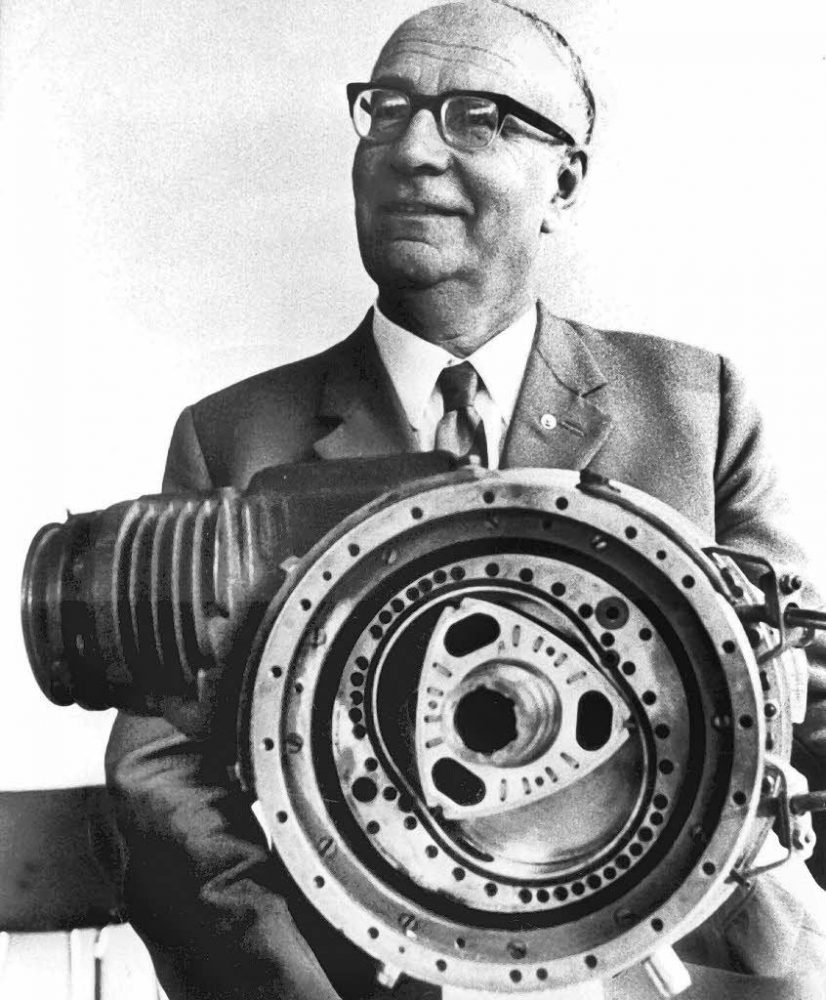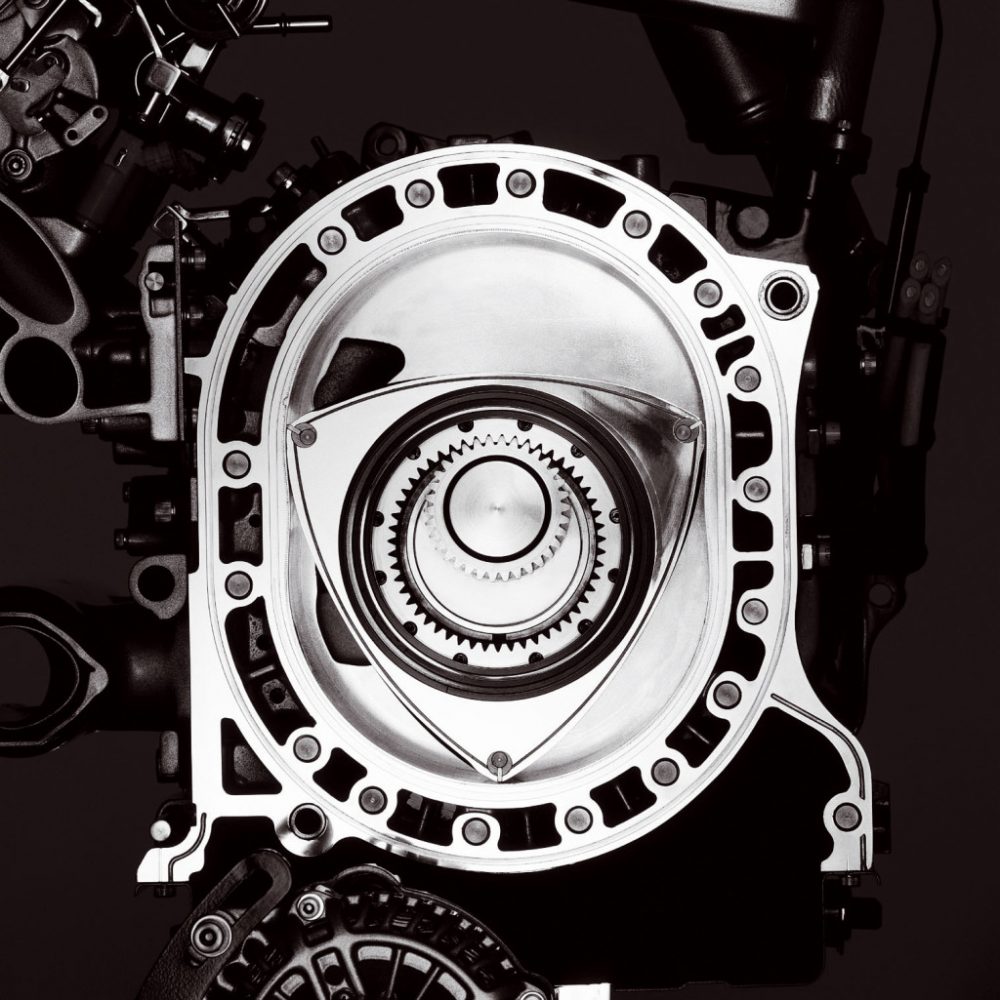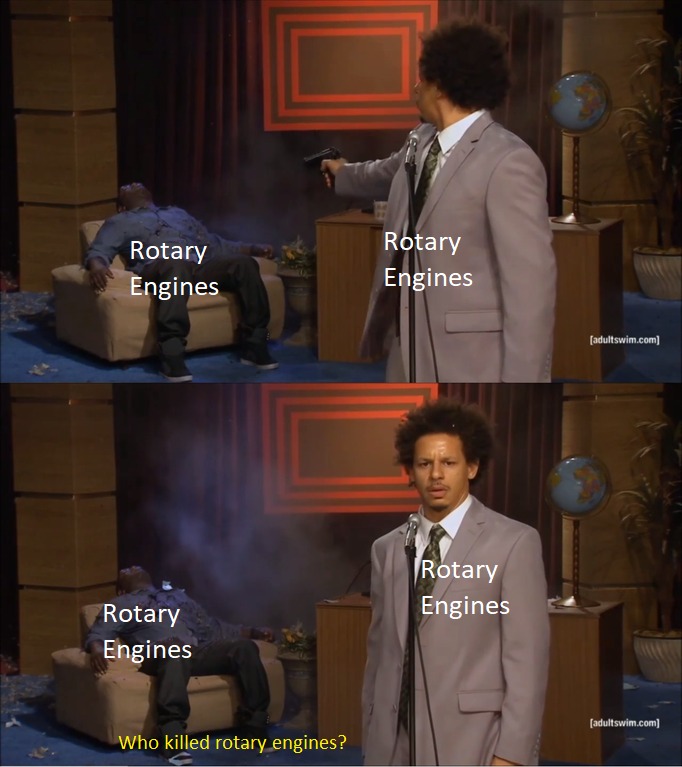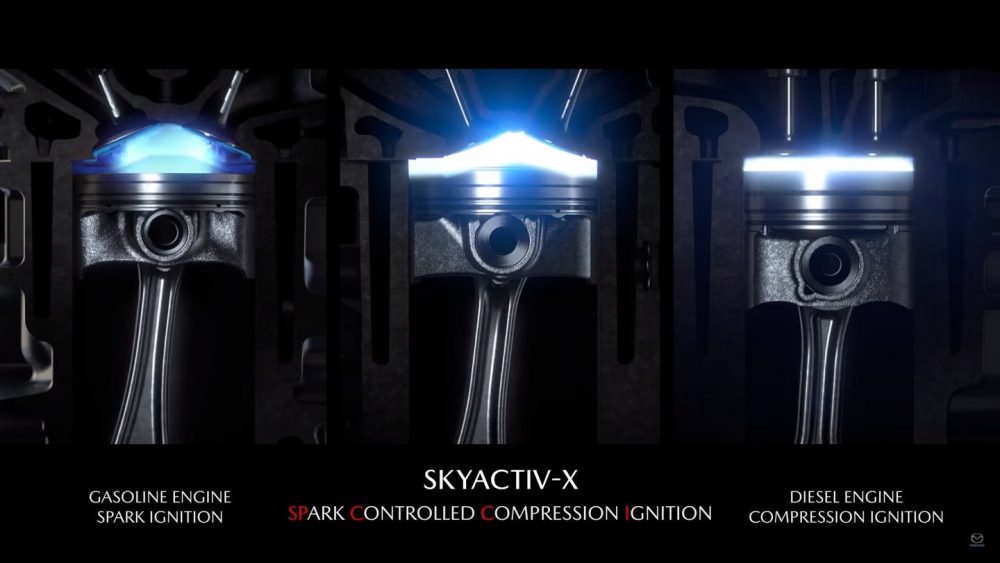Rotary engines could be called a spinoff of a popular engine type. They were strong but inefficient, lightweight but heavily polluting and more of all unsafe. So why is someone’s right mind they would want rotary engines to come back? Because we now have the technology to counter the ill effects of the rotary and make them better. Let’s dive into the world of the Rotary engines.
Rotary Engine | The Birth

In the lab of a German mechanical engineer in 1954, the rotary engine was invented. Felix Heinrich Wankel was the man behind it. He wanted to make an engine that didn’t have strong vibrations like a piston engine. And he was successful, the Wankel Rotary engine (DKM54) was up and working but wouldn’t find its way into cars till 1956 when it was modified by another engineer Hanns Dieter Paschke who made it cheaper making mass production possible.
So what impact did rotary engines make on the cars of the old and why were they forgotten by every company except one that won’t give up on them? Lets took a look at what rotary did right and where they messed up big time.
Rotary Engine | Power Incarnate
While an IC engine can provide a great amount of BHP the rotary engine can do the same but better. Something like a 1.3-Litre rotary engine can produce 228 BHP while the IC engine can produce a maximum power output of 170bhp. Don’t forget the fact that Rotary engines are very small compared to an IC engine.
Rotary engines are powerful at a cost. They don’t use fuel to power themselves. They drink it. There was a reason rotary engines died. Let’s take a look at how they used to work.
Rotary Engine | Basic Working Principle
The rotary engines convert pressure into rotation motion just like every other fuel oriented engine ever. So what made them better? It was the number of parts they needed to make this rotatory motion. They didn’t need any ‘accessories’ like the piston engine
While piston engine which converts pressure into linear motion which is then converted into rotation using cranks. The rotary engine directly generates rotation. This meant less power loss and the rule of thumb states the more the parts the more loss will be present.
Rotary Engine | The Parts
Rotary has only three major parts that are used. There are other parts but we are comparing it with a piston engine so we will only talk about parts that are used to generate power and our a bit different than the piston.
The Rotor | Kinda Obvious

The convex faced triangle-shaped part in the middle is called the rotor. It is the equivalent of a piston. It rotates and that’s how it works thanks for reading the blog. On a serious note, it rotates around the chamber in which it’s housed triggering the four cycles of an engine which are the intake, compression, combustion and exhaust cycles. All of these steps occur in a different part of the chamber which is dedicated to them.
The Chamber | Making Everything Work

The chamber is the place where the magic happens. It houses the rotor as we said above but it also features a plethora of other things that help run the engine.
First is the fuel injector. Pretty basic stuff if you’ve studied about IC engines. The injector in rotary works the same way. The place where air-fuel mixture is introduced in the chamber this is also the part where compression stroke occurs after the intake of the air-fuel mixture is done
Suggested Read: Ford Vs Ferrari | An Epic Rivalry | A True Story
Second, are the two spark plugs. Yeah, the rotary has to two spark plugs. Due to the shape of the chamber, the engine needs more than one spark plug. These two spark plugs ensure the fire spreads evenly around the ignition stroke.
The third is the exhaust vent which throws the un-burnt fuels and the gases out of the engine.
After this, the rotor is back at the start position and the cycle continues.
The Uses Of Rotary
From powering sports cars to World War fighter planes, rotary saw use in everything. Anything that needed speed and performance employed the use of rotary engines. The most common cars that had Rotary engines were the Mazda’s RX series.
But if they are so versatile and good why did they start diminishing and ultimately killing them?
Rotary Engines | What Killed Them

Just like the above image said, rotary engines killed themselves. Both literally and figuratively. As they could just explode anytime they desired and figuratively because they were crude. As much as I love rotary engines they were a bad piece of hardware.
EXPLOOOOOOSIOOOOONNNNNN

The biggest problem with the rotary engine was the MAD RAW POWER they generated. Wait that should be a positive thing right? Well, yes but actually no. high power comes through high RPM which means problems. If you wanna have a small idea of how hard it was to manage a car with a rotary engine we put some points below.
- Start the car and put the revolution on slow not reaching high levels for a maximum of 20 minutes depending on the outside temperature.
- Then you need to warm up the oil in the engine and make sure the water gauge in your dashboard doesn’t go overboard as it will heat up fast.
- When the above conditions are met that’s when you begin the race because the only reason to get a rotary engine is to race with it.
- Also, you need to rev as hard as you can to make sure the engine is lubricated.
If you did all these steps and you had good luck, you get to ride your car another day. Although it was not a common thing, we won’t take even a slight chance of an engine exploding over no chance to explode.
Popular Read: The Indian Automobile Industry Highlights Of 2019
Rotary Don’t use Fuel They Drink It

Should be obvious enough from the title, the rotary was inefficient. It had a fuel economy of 19.7 km/l. This one was the best economy that we had ever gotten from a rotary engine. So it only goes down from that. This was a major issue driving people who just wanted the car for personal reasons instead of using it to race or drift cars.
Breathing Is Fun | Rotary Says No
The emission of rotary was off the charts. With Nox level reaching high levels, Rotary was polluting. This caused rotaries to die in the European Union when they introduced a new emission norm that the rotating engines couldn’t keep up with.
The Comeback?
So if they have such major red flags around them why even Mazda bother bringing them back. It’s not about having an alternate powertrain option, it’s about keeping the heritage alive. With all those problems rotary shouldn’t even be a thing so why do we think rotary will come back.
Don’t Call This A Comeback Rotary Never Left
Even though every company that tried dabbling in rotary engines gave up on them, Mazda didn’t. They kept on introducing new options and technologies to make rotary work. Slowly and steadily they realized it doesn’t matter as there are too many flaws to make it work. But they are still going strong, with reports Mazda patenting new technologies concerning rotary engines hope is still strong for the Rotary.
Sky’s The Limit When You Don’t Give A Damn | The SkyActiv X Tech
Mazda made an engine called the SkyActic X. Working of an engine with this tech is a really smart thing as it removes the problem of an IC engine which is its emission and efficiency.
SkyActiv X Working

These engines are a mixture of both diesel engine and petrol. It uses the concept that these engines employ which is Spark plug ignition and Compression Ignition.
The chambers in Skyactiv X use a 16:1 lean fuel mixture. This allows for less heat generation as there is more air. This lean mixture is then compressed by the piston and when its almost at the self-ignition point due to pressure a spark plug ignites it. This Mixture of both ensures less temperature which reduces Nox emission and less heat which means more energy is used to run the car instead of being wasted away.
So why did we discuss a technology that is used in a piston engine? It because of the combination of SkyActiv X and rotary engines, rotary can take the market with high-performance cars that luckily won’t explode while you are out for a drive.
The Fusion Of Rotary And SkyActiv X
There are some points on how the use of SkyActiv X and Rotary can drastically change the two major problems, emission, and efficiency. Exploding rotary engines might be a problem but they were not common at all.
High Compression Ratio| Controls Emission
SkyActiv X uses a 16:1 really high compression ratio. And studies have shown that it is possible to reach the same ratio on a rotary with this tech in it. This means less emission has its more air which results in lower temperatures which further causes less Nox emission as Nox emission is directly related to temperature
S.P.C.C.I ( Spark Plug Controlled Compression Ignition) | Controls Efficiency
As we discussed above, the mixture of compression and ignition engine is what makes SkyActiv X good. It ensures a lower temperature and less emission. It also increases efficiency as leaner mixtures burns easily and using SPCCI it burns completely thus leaving no residue.
SUPERCHARGE IT
Supercharging a SkyActiv X rotary engine is the ideal thing to do. As we need to make a 16:1 ration possible we need more air and a supercharger will help us do so. Nothing much to add here as its a normal thing employed by many engines.
Conclusion
Rotary will be coming back. Every rotary fanatic wants them to. Mazda gave us some hope when some patents hinted towards them working on a new rotary engine. They were also spotted saying that they will not give up the dream of making a supercar with a Rotary engine and RX9 will be coming with one. With rumours saying RX9 will have a 400+ bhp engine which is pure power rotary will take the centre stage, for how long that’s for time to decide.
More Informative Reads: Should You Buy An Electric Car Or a BS6 Car In 2020?
[yop_poll id=”72″]






Not wanting to be rude, but there is a substantial lack of understanding in this article. In regards to spontaneous explosion, you’d seldom find that on a well built rotary, just like a well built piston engine. In terms of fuel consumption, at constant engine speed, rotary engines are more fuel efficient as they have significantly less internal resistance and actually use less fuel than piston engines. Finally, when it comes to reliability, rotary engines are significantly more reliable than piston engines when the engine needs to run at peak power continuously.
Hi, first it’s not rude at all. Having discussion allows both parties to gain knowledge and I always welcome a civil discussion. As for your points. You are correct that well-built rotaries won’t explode but they are however more prone to exploding than a piston engine which I have mentioned in the appropriate section. This is due to their bad heat dissipation they are prone to exploding. It doesn’t mean all of them explode. About fuel consumption, rotaries are bad with their fuel economy as they do not completely burn all the air-fuel mixture in the chamber. This is visible when a rotary car is throwing flames from the exhaust which is actually the air-fuel mixture burning in the exhaust valve instead of the combustion chamber. As for reliability I completely agree with you, rotary offer more power than a piston engine for the same size and for longer distance, they do however are not built to last and need quite a lot of maintaining.
Great article. I enjoyed reading it. A company called Liquid Piston has already solved problems with the Rotary Engine. If Mazada pursues the rotary it would be wise of them to contact Liquid Piston and move forward together
I have a 12a turbo in my RX4. It was put in second hand from Japan in 1994 (I returned from living in Europe for 6 years). It has an aftermarket ECU and an intercooler conversion. It does not spit flames out the exhaust. It has never been pulled apart and it’s still running. I say again it’s still running. So, to those who say they’re not reliable, I say foey!
There have been big advances in aftermarket apex seals over the last few years, and billet plates are now available. Also, rotaries can run hydrogen (fuel of the future) because they don’t require overlap/porting to make reasonable power.
I have a 12a turbo in my RX4. It was put in second hand from Japan in 1994 (I returned from living in Europe for 6 years). It has an aftermarket ECU and an intercooler conversion. It does not spit flames out the exhaust. It has never been pulled apart and it’s still running. I say again it’s still running. So, to those who have never owned one and say they’re not reliable, I say foey!
There have been big advances in aftermarket apex seals over the last few years. Billet plates are now available and Liquid Piston’s take on the rotary is also highly interesting. Also, rotaries can run hydrogen (fuel of the future) because they don’t require overlap/porting to make reasonable power.
I did not find any other place to make my point. I have owned one wankel for 2 months now but i have studied about it and finally when i got 1 i have to say i love it. It not very durable bc people wear em out pretty fast with.. they can not use them properly?
So first, we have better consumer point lubrication oils than ever before. Why dont we use em? 2ndly, oil from engine, bad decision concerning about the firing even, we need auxilary source with stuff that will ignite also but lubricates as well. 3rdly, mazda, apex, lubrication. What would grand sustainable lubrication method via piston to seals? 🙂 4th, constant torque output through whole rev band, makes it easier to drive. 5th, take head out of your arse hole, sry 😀 6th, 3 way catalytic, i had only 300ppm hc and that is least amout that new 4 strokes will give if not put any kind of catalytic converters in the pipe, and i dont have any. List is endless… not limited intake and comb chamber are giving it an opportunity to become a ethanol machine ;D
and liquid piston is has limited features in it, everybody else gave red flag for it and only way to make it pay is sell it for mazda? 😀 sounds legit marketing
I know zip about engines. Of any flavor. But your writing is wonderful and it’s possible that I love you. Thank you for furthering my awareness (if not comprehension) of engines. The notion of a hydrogen-powered, truly non-polluting car in the not too distant future is now on the plus side of my Reasons to Live Another 20 Years chart. (It’s the only item on that side, so things are not looking good overall.) Cheers anyway!
~ Ignorant but admiring